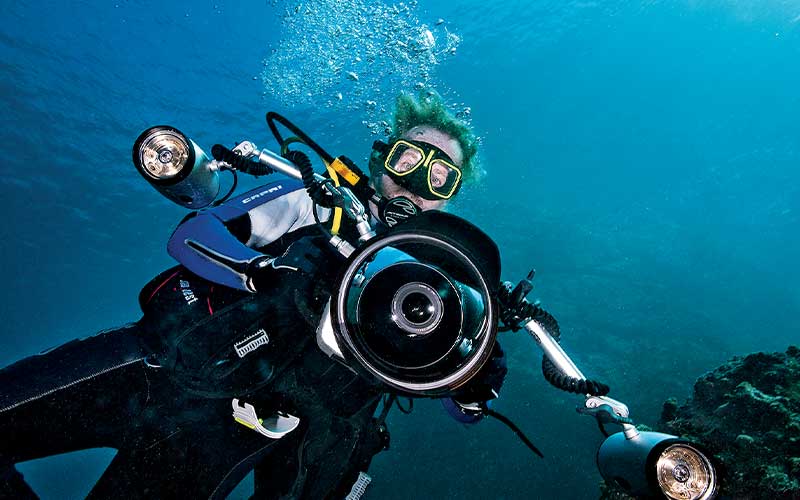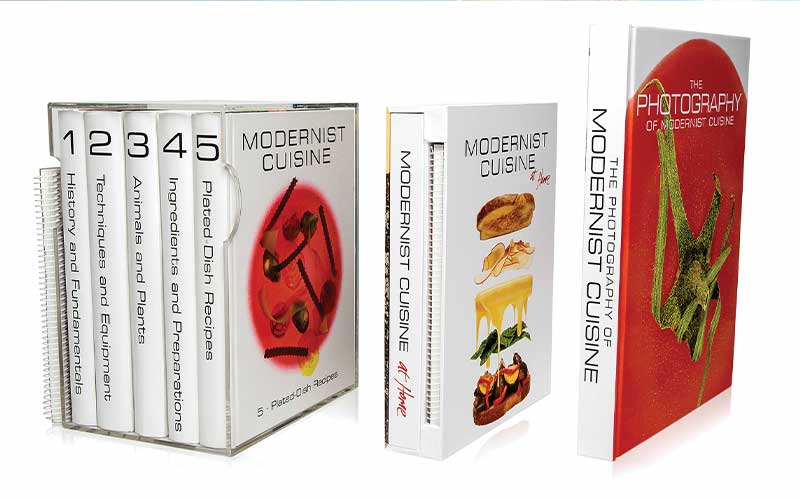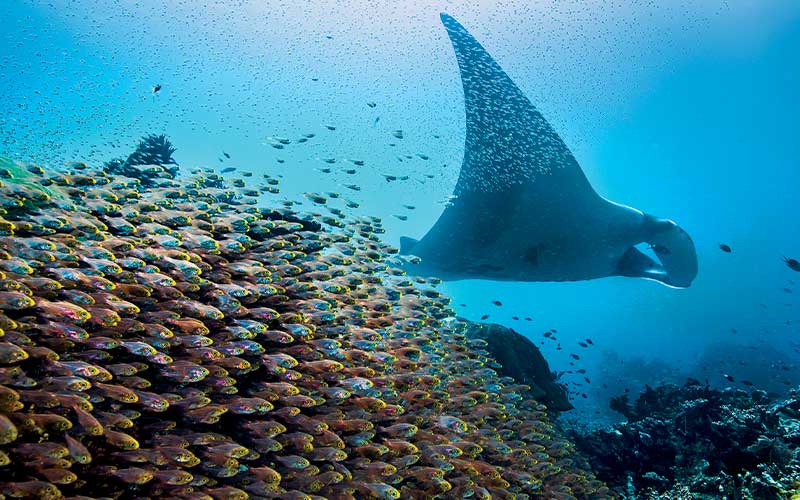Hometown: Born in Seattle; grew up in Santa Monica, Calif.; now resides on Lake Washington, Bellevue, Wash.
Years Diving: 16
Favorite Destination: “Raja Ampat so far, but I’m having fun looking for more.”
Why I’m a DAN Member: “I like Alert Diver. I like being informed. I like the insurance and emergency services I hope never to use”
There is a hazard to reading the curriculum vitae of Nathan Myhrvold: It may make one feel like a comparative slacker. First there are the degrees — a bachelor’s degree in mathematics from the University of California, Los Angeles; a master’s degree in geophysics and space physics from the University of Southern California; master’s degree in mathematical economics and a doctorate in theoretical and mathematical physics from Princeton. Then there is the post-doctoral fellowship at the University of Cambridge working with Stephen Hawking on quantum-field theory in curved spacetime and theories of gravitation.
Myhrvold also is the author of Modernist Cuisine: The Art and Science of Cooking, which was recently hailed by Forbes magazine as “the world’s most influential — and profitable — cookbook.” This 2,438-page, six-volume set is lavishly illustrated with Myhrvold’s own photographs; it weighs 43.5 pounds and costs $625. Self-published, using the best paper Myhrvold could find and at the highest production value possible, his relatively modest initial pressrun of 6,000 copies has now grown by tens of thousands in additional reprints and grossed $30 million. Plus it’s the first book of a trilogy — the comparatively slender, 456-page Modernist Cuisine at Home has now printed in the range of 100,000 copies, and the coffee-table book The Photography of Modernist Cuisine is coming soon. Despite his achievements as an author and chef (he has been a celebrity judge on Top Chef and won the World Championship of Barbecue in 1991), it his primary career track that is most inspiring.

Following graduation Myhrvold founded Dynamical Systems, which Microsoft acquired in 1986. That was the springboard for a 14-year career with Microsoft as chief technology officer, during which time he founded Microsoft Research. Today he is the founder and chief executive officer of Intellectual Ventures, a company that creates, funds and commercializes inventions. He personally holds 328 patents on topics ranging from digital displays and 3-D graphics to surgical staples and genomic selection and has another 859 patents pending (at the moment). Much of Intellectual Ventures’ work is aimed altruistically at the developing world and includes technology that uses lasers to zap malaria-carrying mosquitos, advances to keep vaccines cold and viable in sub-Saharan heat and work to mitigate health hazards from HIV and influenza. Intellectual Ventures was among the top-10 patent generators in the United Sates last year, and it maintains the world’s largest patent portfolio.
It was a love of diving and photography that brought Myhrvold to the DAN® community. He has been interested in photography his whole life. He bought his first camera, a $2 Contax rangefinder he stumbled across at a Salvation Army store, when he was only 9 years old. He had his own darkroom growing up and was a passionate advocate of Ansel Adams’ zone system for black-and-white photography — a means to extract the ultimate in contrast and tonal scale from a negative by means of selective processing and printing to control highlights and shadow detail. He experimented with large-format cameras, including a Deardorff 5×7 field/view camera, but as you might expect from a mind nimble in both technology and creativity, he was an early and eager convert to digital photography.
Instead of underexposing and overdeveloping, or employing any of the other myriad tricks of the analog age, Myhrvold embraces what modern cameras and computers can do with an image. He speaks to the challenges of dynamic range in his typical analytical way: “Dynamic range is the term for the difference between the lightest part of the picture and the darkest.
A typical outdoor scene may have a ratio of light to dark of 4,000:1 — the bright parts are 4,000 times brighter than the dark parts, but scenes can easily go higher than that, up to 1,000,000: 1 if you have a dark shadow in one corner and the sun itself in another. Human eyes have an automatic system that compensates for this, allowing us to see both bright highlights and dark shadows simultaneously. Not so with cameras. Analog color film typically has a dynamic range of 32:1, or five f-stops (one f-stop difference is a factor of two in illumination). Digital cameras are a little bit better at about six to maybe seven f-stops, or 64:1 to 128:1, or maybe a little more. A lot of the problem of picture taking is how to stuff 4,000:1 dynamic range into the much smaller range of the sensor.” That is the kind of background noise that passes through his amazingly active mind with every click of the shutter.

His immersion in scuba diving came a bit later. The inspiration was that of so many of us: the televised 10-year run (1966-1976) of The Undersea World of Jacques Cousteau. Myhrvold was only 11 when the series began and was a college student by the time he was 14, so it might seem unlikely that this would provide lifelong inspiration. Yet so active was his imagination the fantasy of underwater exploration never left him. These documentaries provided the spark that finally ignited decades later when he convinced some of his friends at Microsoft to go to Hawaii and get certified. He already had a housed Nikon camera at that time, which he had used while snorkeling in the Galapagos and elsewhere. But finally being certified allowed him the luxury of time — unhurried access to marine life and an opportunity to perfect his underwater photo techniques.
Myhrvold contends the two most compelling reasons for underwater photographers to shoot digital are being able to acquire more than 36 images per dive and the fact that immediate review is such a powerful educational tool. He considers the prompt feedback cycle of digital photography instrumental in accelerating the learning curve for so many people so quickly — to the extent that there are a plethora of extraordinary marine images floating in cyberspace these days. The opportunity to create is now much greater than in the film era, when one had to be consciously committed to underwater photography as a function of expense and degree of difficulty.
Enhanced technology and pervasive access to imaging tools (with even smartphones being adapted to underwater use) coupled with the ease of transmitting and sharing images, underwater photography now is in a period of renaissance. That’s not to say Myhrvold has been willing to compromise in quality just because easy imaging solutions are out there. He still travels the world with several bulky Canon DSLR camera bodies and a variety of underwater housings, ports, accessory viewfinders and strobes that further encumber his dive trips.

Myhrvold has been profiled in a variety of media for a variety of reasons. Early in our acquaintanceship I recall passing through an airport and seeing his name in a cover line of Men’s Journal, “How a Geek Grills a Burger.” I purchased the magazine to read on the plane and discovered beyond our shared love of underwater photography his interests are astonishingly eclectic. Trying to drill down past the patents, paleontology (he is a Tyrannosaurus rex aficionado), diving and countless other pursuits to cooking, the authors were challenged by his diversity of interests. “But we’re not here for the dinosaurs — or to review what Myhrvold learned studying astrophysics with Stephen Hawking or to discuss his Formula One race-car period or the bungee jumping or nature photography or scuba diving or spelunking or fly-fishing. We’re in his vast and brightly lit laboratory, surrounded by glass beakers and humming machines, to talk about food. And not just food but, in fact, molecular gastronomy, the avant-garde approach to cooking that uses chemistry and technology to invent novel, even ludicrous, edible creations.”
As they discovered, there is no single dimension or descriptive to contain the essence of Nathan Myhrvold, and we can expect this renaissance man to further evolve.
© Alert Diver — Q4 Fall 2013